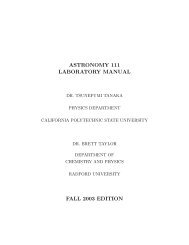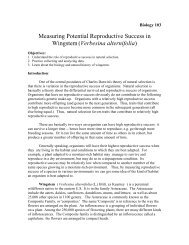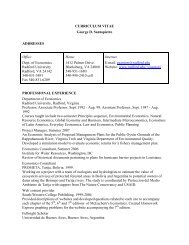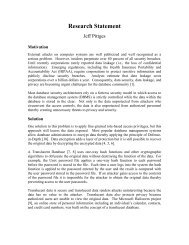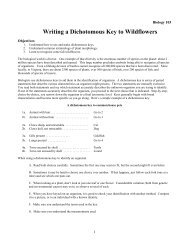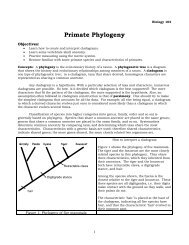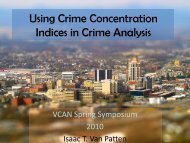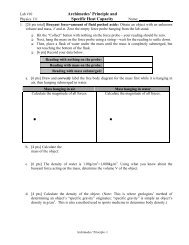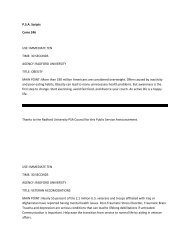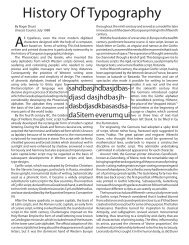Test 3, March 29, ART216 ANSWER KEY PT1: 20 questions total; 2 ...
Test 3, March 29, ART216 ANSWER KEY PT1: 20 questions total; 2 ...
Test 3, March 29, ART216 ANSWER KEY PT1: 20 questions total; 2 ...
You also want an ePaper? Increase the reach of your titles
YUMPU automatically turns print PDFs into web optimized ePapers that Google loves.
<strong>Test</strong> 3, <strong>March</strong> <strong>29</strong>, <strong>ART216</strong><br />
<strong>ANSWER</strong> <strong>KEY</strong><br />
<strong>PT1</strong>: <strong>20</strong> <strong>questions</strong> <strong>total</strong>; 2 points each; Image Ids: 10 <strong>questions</strong>, 1 point each<br />
c<br />
D<br />
A<br />
1. The form of baroque art most closely associated with the taste of a king is:<br />
A) Italian baroque B) Flemish baroque C) French baroque D) Dutch baroque<br />
2. Paintings of musicians making music are common to which one of the following:<br />
A) Italian baroque B) Flemish baroque C) French baroque D) Dutch baroque<br />
3. Italian baroque architecture is characterized by two of the following. Which one is<br />
NOT true of Italian baroque architecture?<br />
A) the use of geometric modular planning<br />
B) the creation of flowing interior spaces which defy a perception of units<br />
C) a preference for unstable geometric forms<br />
C<br />
4. Which of the following characteristics is generally NOT true of baroque art,<br />
especially in Italy? (Choose one)<br />
A) the use of allegory<br />
B) theatricality<br />
C) the idealization of nature<br />
D) symbolic light and tenebrism<br />
E) dynamic compositions which confront the viewer by intruding on his or her space<br />
or sensibilities<br />
th<br />
5-8. Four of the following types of paintings were not seen before the 17 century. Which<br />
ones are they? Choose FOUR and name one artist for each type you choose in order to<br />
receive full credit. Each correct pair is two points.<br />
A) the family portrait<br />
B) the group portrait: Hals or Rembrandt<br />
C) the market scene<br />
D) the fête-galante: Watteau<br />
E) the heroic landscape: Poussin<br />
F) the poetic landscape<br />
G) the allegorical painting<br />
H) breakfast pieces: Peeters<br />
9. Name two artists who are known for their pastel portraits.<br />
1 point for each if correct; no points if wrong; no more than 2 points<br />
Carriera, Wright, Labille-Guiard<br />
10. What is meant by the phrase “a taste for the natural” in terms of 18 century art? Identify<br />
th<br />
TWO characteristics implied by this taste.
Some possible answers include:<br />
• Rejection of the artificial or artifice of rococo<br />
• rejection of the aristocracy<br />
• desire for moral paintings<br />
• desire for paintings about the middle and lower classes<br />
• the influence of Roussea – desire for simplicity and the primitive<br />
NOTE THAT NATURALISM IS NOT A CORRECT <strong>ANSWER</strong>; also note that pastel portraits<br />
reflect the desire for the natural but they are not a characteristic of the taste for the natural<br />
11. Why did the Royal Academy of Art invent the genre of the fête-galante?<br />
1 point if half the answer is given; two points for both halves<br />
1)To admit Watteau and 2) to de-politicize his painting Embarkation to Cythera<br />
You might also have said that the Academy was faced with an unfamiliar genre and created<br />
the category specifically for Watteau. You did need to mention the artist’s name for full<br />
credit.<br />
12. What invention contributes to the increasing popularity of the pastel portrait and how<br />
does it do this?<br />
• Easier to make pastel crayons (only 1 point)<br />
• invention of glass (only 1 point)<br />
• invention of glass – this protects the pastel painting and makes the surface shiny like<br />
an oil painting (2 points)<br />
Choose your answer to the next 5 <strong>questions</strong> from this list:<br />
A) Italian baroque B) Dutch baroque C) French baroque D) rococo<br />
B____13. The merry company is a popular genre of painting.<br />
A____14. Most closely associated with the use of tenebrism.<br />
B____15. The middle class becomes an important consumer of art.<br />
D____16. A new type of painting in this style is the “intrigue” painting.<br />
D____17. Rubens is an important influence on this style.<br />
C____18. The artist responsible for spreading the influence of the Italian baroque style is<br />
generally thought to be: A) Bernini B) Caravaggio C) Gentileschi D) Garzoni<br />
19 - <strong>20</strong>. Both Poussin and Claude are French baroque landscape painters but their landscapes<br />
are generally very different.<br />
What is the correct term for Poussin’s landscapes? Heroic landscapes; grand manner<br />
landscape (either is acceptable) (1 pt)<br />
What is the correct term for Claude’s? Pastoral landscape is correct but I accepted poetic<br />
landscape for this question (it is not a new type of painting; therefore not accepted for<br />
<strong>questions</strong> 5-8) (1 pt)<br />
What characteristics make them different? (2 of the following for 2 points)<br />
Poussin includes classical/heroic narratives – there are usually people and architecture in the
painting – the narrative has an important meaning<br />
the landscape and architecture together have a structured, composed quality<br />
Claude creates more lyrical, natural scenes; when people are present, they are not the<br />
source of meaning; atmospheric use of light (as opposed to the clarity of Poussin)<br />
EC: (2 points) Why do regional differences become less noticeable or prominent in the 17 th<br />
century?<br />
Some of the following:<br />
Artists are traveling to other countries and are influenced by a broader selection of art<br />
Print materials make it easier for artists to see other art works.<br />
Kings (like Philip) have large collections of art from different regions and artists who have<br />
access to the King’s collection see more art<br />
Images:<br />
1. B<br />
2. C<br />
3. B<br />
4. C<br />
5. D<br />
6. E or B<br />
7. G<br />
8. D<br />
9. C<br />
10. C



